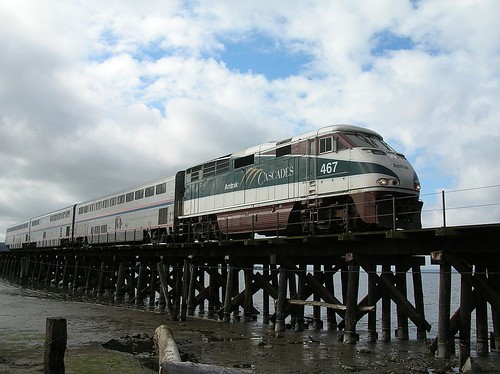
readers said is bike-friendlier than many.
(Photo by Stephen Rees.)
A late-night incident in which Amtrak workers awoke two Portlanders to tell them, incorrectly, that their folding bikes weren’t allowed as carry-ons has led the agency to clarify its policy.
Amtrak spokeswoman Vernae Graham said last week that every passenger car in the system allows folding bicycles as carry-on luggage “if they fit the dimensions described in the policy and can fit in the areas designated for carry on baggage or bikes.”
The maximum dimensions are 34 inches by 15 inches by 48 inches, as stated in Amtrak’s policy. Mass-market folding bikes meet those constraints, Dean Mullin of local shop Clever Cycles said Wednesday.
In addition, a different Amtrak representative told Elly Blue and Joe Biel of Portland that the national passenger rail company has sent a memo about its bicycle policies to all on-board staff, a number that Blue said is between 10,000 and 15,000 people.

(Photo by Christopher Lance.)
On Dec. 2, Blue said, while she and her partner, Biel, were riding in a sleeper car through Texas on a business trip, Amtrak employees woke her at 11 pm and made a series of seemingly inaccurate claims, including one that she and Biel would have to deboard, purchase two of Amtrak’s bike boxes and pay to check their folding bikes to their destination, despite the policy saying foldable bikes are valid carry-on baggage.
Blue said Debbi Stone-Wulf, Amtrak’s chief of sales distribution and customer service, “apologized profusely” for the mix-up and said that “all the staffers involved in our incident have by now had ‘multiple conversations’ with management about it.”
In a long comment thread beneath our story about Blue’s experience and on social media sites, many Amtrak riders offered suggestions or frustrations to the publicly owned company. Blue passed many on to Stone-Wulf in the form of a curated list.
“It is clear from your list that we can probably fix some things just by being more clear about our policy and effectively communicating that to our customers and employees,” Stone-Wulf wrote in an emailed reply to Blue. “That is good news as those are relatively easy things for us to do. … I plan to review your list with my team to use as a guide as we are putting our plans together to improve the customer experience for our bicycling customers. I’ll keep you updated as we move along and begin to make progress.”
Blue adds that she has “cautious optimism” about further improvements at Amtrak with regard to bikes, starting with the launch last week of an automated interactive guide for Amtrak staff called “Super Julie”:
I think the biggest change, though, will come from Super Julie — this has been in the works for a year and just launched last week, unrelated to our incident (though very much related to the bigger picture problem behind our incident. Essentially, it means that staff will no longer be operating from a constantly updated series of paper manuals, but instead will have access to a very comprehensive version of the customer-facing “Julie” CMS that we know and love. It means that all staff now have instant, online access to consistent policy information. I do suspect it’ll make a big difference.
In the longer term, Stone-Wulf is part of a new Amtrak task force that’s focused on “providing better service to the bicycling community.” Since bikes and trains can be such a perfect match for travelers, we’ll be eager to report on the outcomes of this task force’s work.


